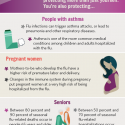What To Do After A Tick Bite: Preventing Lyme Disease
Warm weather usually indicates the need to be on the lookout for ticks. But why do we need to be alarmed if we find a tick?
Ticks are known to carry diseases, such as Lyme disease. According to the Centers for Disease Control and Prevention, approximately 30,000 cases of Lyme disease are reported each year. Lyme disease is caused by bacteria found in infected ticks and is spread by the bite of a tick.
Signs and symptoms of Lyme disease
Below are the early and later signs and symptoms of Lyme disease. If you are concerned about a possible tick bite, talk to your doctor. Lyme disease can be treated with antibiotics. Most people recover within a couple of weeks. Other signs and symptoms may exist and are not limited to the ones listed.
Early signs (3 to 30 days after tick bite):
- Fever
- Chills
- Headache
- Fatigue
- Muscle and joint aches
- Swollen lymph nodes
- Bullseye rash, also known as the Erythema migrans (EM) rash
Later signs (days to months after tick bite)
- Severe headaches and neck stiffness
- Additional bullseye rashes on other areas of body
- Intermittent pain in tendons, muscles, and joints
- Loss of muscle tone or droop one or both sides of face
- Irregular heart beat
- Nerve pain
- Dizziness or shortness of breath
- Short-term memory loss
Preventing Lyme Disease
You can prevent tick bites by following a few simple steps:
- Avoid wooded or overgrown grassy areas.
- Use insect repellent on skin and clothes. Be sure to follow the product instructions. For more information on what to look for in your repellent check out: https://www.cdc.gov/lyme/prev/on_people.html
- Bathe or shower as soon as possible after coming indoors from wooded or grassy areas.
- Perform a daily tick check, including behind the ears, belly button, between the legs, and in and around all head and body hair.
- Examine clothes, children, and pets for ticks.
- Tumble dry clothes on high heat. This will kill the tick if they are attached to any clothing article.
What To Do After a Tick Bite
Don’t wait to remove it. Follow these steps as soon as you notice a tick:
- Use fine-tipped tweezers to grasp the tick. The closer to the skin surface, the better.
- Pull upward with steady, even pressure. Make sure you don’t twist or jerk causing parts of the tick to break and remain.
- After removing the tick, thoroughly clean the bite area and your hands. You can use rubbing alcohol, an iodine scrub, or soap and water.
- Dispose of the tick. Never crush a tick with your fingers.
For more information check out the resources below or discuss with your doctor.
Resources:
Center for Disease Control and Prevention:
https://www.cdc.gov/lyme/index.html
Medline Plus




